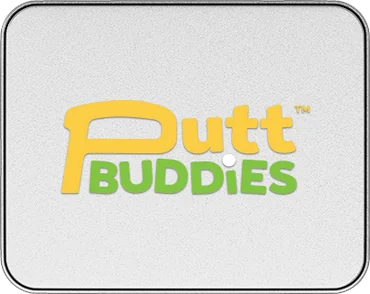
How to Use a Divot Tool | PuttBuddies
Golf is a game of skill, strategy, and sportsmanship, but it’s also a game of respect for your fellow players and the course itself. One of the most important aspects of golf etiquette is repairing divots, those small indentations left on the green when a golf ball lands. Using a divot tool is a simple yet essential part of maintaining the quality of the course and ensuring a smooth playing experience for everyone.

What Is a Divot and Why Does It Matter?
A divot is a small depression or mark left on the green when the ball makes an impact. While divots can occur on the fairway or rough, the ones that matter most to repair are those on the putting green (especially on par 3s), as they can affect the roll of the ball for subsequent players. These marks might seem insignificant at first glance, but they can greatly impact the quality of play.
When a divot is left unrepaired, it can create uneven surfaces that disrupt the ball’s roll, making putting more difficult for the next group of golfers. Over time, if divots aren’t repaired, the green can become pockmarked and damaged, which affects the entire course. Properly repairing divots not only keeps the green smooth and fair but also helps maintain the course’s health, ensuring that grass recovers quickly and remains lush and playable. If you’ve ever played on a public course, you know just how bad greens can get!
What Is a Divot Tool?
A divot tool, also known as a ball mark repair tool, is a small, often forked tool designed to repair the marks left by golf balls on the green. These tools are usually made of metal or durable plastic and come in various shapes and sizes. The basic design includes two prongs that are inserted into the turf around the edge of the divot, allowing you to gently work the grass back into place.
There are several types of divot tools available, each with slightly different designs:
- Standard Two-Prong Tool: The most common and straightforward design, featuring two prongs that you insert into the turf around the divot.
- Switchblade Divot Tool: A more modern version that retracts the prongs into the handle, similar to a switchblade knife, making it compact and easy to carry.
- Single-Prong Tool: A simpler design with just one prong, which some golfers find easier to use for precision repairs.
- Multi-Tool: Some divot tools come with additional features like a ball marker or club rest, -adding extra functionality.
- PuttBuddies Divot Tool: A two pronged multi-tool that adds art and creativity to the standard plain divot tools.
How to Use a Divot Tool Correctly
Step-by-Step Guide to Repairing a Divot
Using a divot tool might seem straightforward, but there’s a correct technique to ensure that you repair the green properly without causing further damage. Here’s a step-by-step guide:
- Locate the Divot: Identify the mark left by your ball. It’s important to repair your divot immediately to ensure the grass recovers quickly.
- Insert the Tool: Take your divot tool and insert the prongs into the turf at the edge of the divot, not directly into the depression. Insert the tool at a 45-degree angle.
- Push Toward the Center: Gently push the edges of the divot toward the center of the depression. This helps bring the grass back together, allowing it to heal more quickly.
- Avoid Lifting the Turf: Don’t lift the turf upward, as this can damage the roots and slow the recovery process. The goal is to compress the turf back into place, not pull it up.
- Smooth the Surface: After working the grass back into place, use the bottom of your putter or your foot to gently tamp down the area, ensuring it’s level with the surrounding green.
Common Mistakes to Avoid
- Lifting the Turf: One of the most common mistakes is lifting the turf with the divot tool, which can damage the grass roots and slow recovery.
- Inserting the Tool Directly into the Divot: Always insert the tool around the edge of the divot, not directly into the center, to avoid tearing the grass further.
- Not Pressing Down the Turf: Failing to smooth out the area afterward can leave the green uneven, defeating the purpose of the repair.
When Should You Use a Divot Tool?
You should always repair any divots you create on the green as soon as they occur. This is a key part of golf etiquette and helps keep the course in top condition for everyone. It’s also considered good golf etiquette to repair other divots you see on the green, even if they weren’t caused by you. A quick repair takes only a few seconds and contributes to the overall quality of the course.
Why You Need a PuttBuddies Divot Tool?
PuttBuddies stands out in the market with our uniquely creative and thoughtfully designed divot tools, making them a top choice for golfers who value both functionality and style. Each divot tool from PuttBuddies is crafted not just to serve its essential purpose but also to reflect the personality and flair of the golfer. Our designs are vibrant, playful, and innovative, turning a simple golf accessory into a statement piece. Whether you're looking for a tool that adds a bit of fun to your game or one that showcases your individuality, PuttBuddies offers a range of options that go beyond the ordinary. Our divot tools are more than just functional, they're conversation starters on the green, combining practical use with eye-catching aesthetics that set them apart from standard options.
Using a divot tool is a simple yet vital part of golf etiquette. It’s about more than just repairing the green, it’s about respecting the game, the course, and your fellow players. With the right technique and a quality divot tool from PuttBuddies, you can ensure that every round of golf is played on a smooth, well-maintained surface. So the next time you’re out on the green, make sure you have your PuttBuddies divot tool handy, and take a moment to repair those divots. It’s a small action that makes a big difference.


